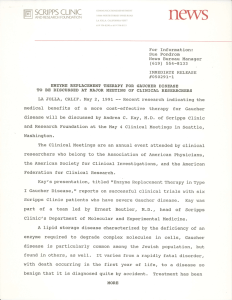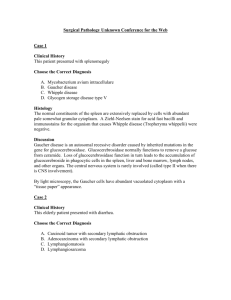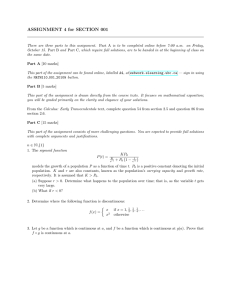ontario guidelines for treatment of gaucher
advertisement
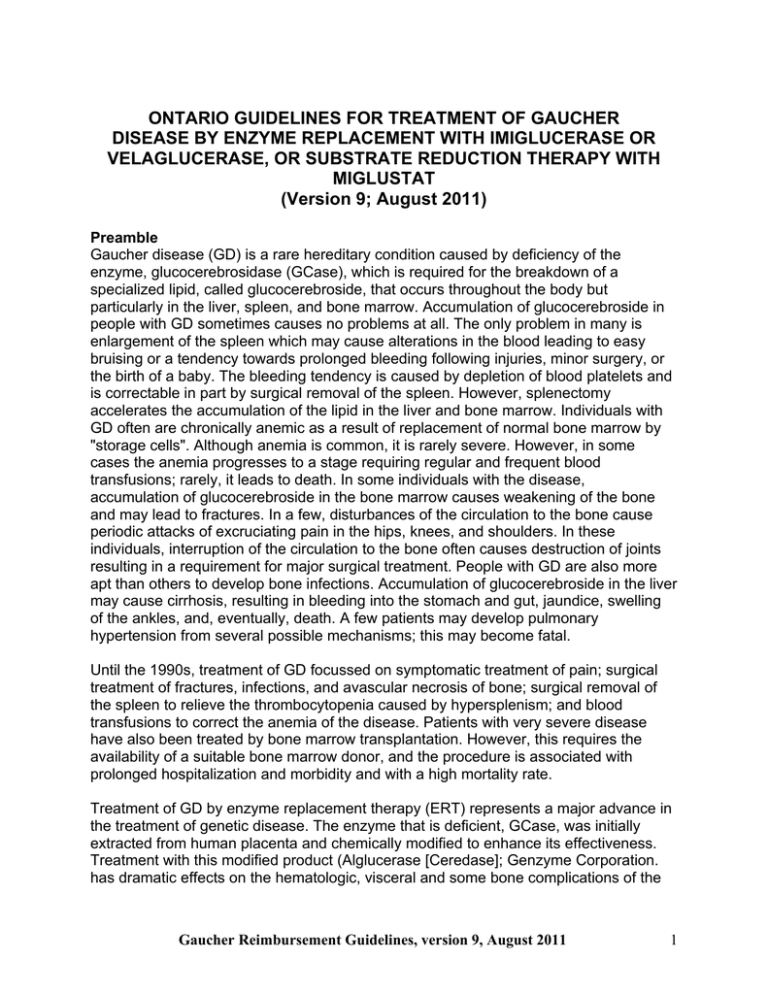
ONTARIO GUIDELINES FOR TREATMENT OF GAUCHER
DISEASE BY ENZYME REPLACEMENT WITH IMIGLUCERASE OR
VELAGLUCERASE, OR SUBSTRATE REDUCTION THERAPY WITH
MIGLUSTAT
(Version 9; August 2011)
Preamble
Gaucher disease (GD) is a rare hereditary condition caused by deficiency of the
enzyme, glucocerebrosidase (GCase), which is required for the breakdown of a
specialized lipid, called glucocerebroside, that occurs throughout the body but
particularly in the liver, spleen, and bone marrow. Accumulation of glucocerebroside in
people with GD sometimes causes no problems at all. The only problem in many is
enlargement of the spleen which may cause alterations in the blood leading to easy
bruising or a tendency towards prolonged bleeding following injuries, minor surgery, or
the birth of a baby. The bleeding tendency is caused by depletion of blood platelets and
is correctable in part by surgical removal of the spleen. However, splenectomy
accelerates the accumulation of the lipid in the liver and bone marrow. Individuals with
GD often are chronically anemic as a result of replacement of normal bone marrow by
"storage cells". Although anemia is common, it is rarely severe. However, in some
cases the anemia progresses to a stage requiring regular and frequent blood
transfusions; rarely, it leads to death. In some individuals with the disease,
accumulation of glucocerebroside in the bone marrow causes weakening of the bone
and may lead to fractures. In a few, disturbances of the circulation to the bone cause
periodic attacks of excruciating pain in the hips, knees, and shoulders. In these
individuals, interruption of the circulation to the bone often causes destruction of joints
resulting in a requirement for major surgical treatment. People with GD are also more
apt than others to develop bone infections. Accumulation of glucocerebroside in the liver
may cause cirrhosis, resulting in bleeding into the stomach and gut, jaundice, swelling
of the ankles, and, eventually, death. A few patients may develop pulmonary
hypertension from several possible mechanisms; this may become fatal.
Until the 1990s, treatment of GD focussed on symptomatic treatment of pain; surgical
treatment of fractures, infections, and avascular necrosis of bone; surgical removal of
the spleen to relieve the thrombocytopenia caused by hypersplenism; and blood
transfusions to correct the anemia of the disease. Patients with very severe disease
have also been treated by bone marrow transplantation. However, this requires the
availability of a suitable bone marrow donor, and the procedure is associated with
prolonged hospitalization and morbidity and with a high mortality rate.
Treatment of GD by enzyme replacement therapy (ERT) represents a major advance in
the treatment of genetic disease. The enzyme that is deficient, GCase, was initially
extracted from human placenta and chemically modified to enhance its effectiveness.
Treatment with this modified product (Alglucerase [Ceredase]; Genzyme Corporation.
has dramatic effects on the hematologic, visceral and some bone complications of the
Gaucher Reimbursement Guidelines, version 9, August 2011
1
disease - on this issue the results of all the reported clinical trials are unambiguous. The
efficacy of ERT in the management of other complications is still under investigation.
(Alglucerase [Ceredase®] has been replaced by a recombinant enzyme, imiglucerase
[Cerezyme®] Sanofi Genzyme.)
Experience has shown that some patients with type I GD (nonneuronopathic GD) do not
tolerate ERT, or cannot qualify for medical, religious, or personal reasons. The
introduction of novel treatment strategies including substrate reduction (SRT) and
enzyme enhancement (EET) (chaperone) therapy represents a potential therapeutic
option for patients in this category. SRT aims to decrease the production of
glucocerebroside, rather than accelerating its elimination; and EET functions by
stabilizing misfolded enzyme.
SRT with Miglustat (Zavesca®; Actelion Pharmaceuticals Ltd.) decreases the production
of glucocerebroside by inhibiting glucosylceramide synthase (UDP-glucose:ceramide
glucosyltransferase).The drug has been shown, in clinical trials, to produce
improvements in the enlargement of the liver and spleen and the anemia and decreased
platelet counts in patients with type I GD. It has also been shown to stabilize therapeutic
gains achieved by ERT. The drug is administered orally, which for some, represents a
major advantage over intravenous enzyme infusion. SRT with Miglustat provides an
alternative for adult type1 Gaucher patients with mild to moderate disease.
Owing to heterogeneity of the condition, the very high cost and advantages /
disadvantages of treatments, expert guidance was judged to be necessary for the
selection of patients for treatment. What follows are some proposed criteria for the
selection of patients and treatment protocol.
At the time of preparation of this document, the following products are commercially
available for the treatment of GD.
ERT
SRT
Ceredase (alglucerase)
Zavesca (miglustat)
Cerezyme (imiglucerase)
Vpriv (velaglucerase)
The purpose of these guidelines is to assist with eligibility for treatment and treatment
modality. The decision to treat will be based on the criteria described below. The choice
of modality will be based on
• recommendation by a physician experienced in the treatment of GD
• patient preference
• clinical and financial consideration.
The choice among the available products must be flexible based on the patient’s best
interests.
Gaucher Reimbursement Guidelines, version 9, August 2011
2
Treatment Contract
As per institutional requirements, patients/substitute decision makers may be required
to sign a treatment contract outlining the responsibilities of all parties.
Guidelines
General comments
The recommendation to provide financial support for treatment of any given patient with
GD will be based on sound clinical judgement; the genotype (i.e. specific GCase
mutations) will not be a factor. The variables providing the best indication of the severity
of disease are the platelet count, hemoglobin concentration, the size of the spleen
and/or liver relative to total body mass, and the amount of bone marrow replacement by
storage cells. The assessment of hematologic involvement and organ size is relatively
easy; the assessment of bone involvement is more difficult. The results of any
deliberations by the Review Committee will be communicated to appropriate officials of
the Ministry of Health. The Committee will not communicate directly with patients under
review. When a member of the Committee is also one of the physicians involved with
the medical care of a patient under review, he or she will be asked to present the case
for treatment.
The Committee reserves the right to review and revise these guidelines
periodically to ensure that they remain consistent with their original purpose.
Criteria for admission to treatment
Resident of Canada
1. The patient must be a Canadian resident who is eligible for drug coverage under one
of the Canadian provincial or territorial health plans, or a federally funded plan such as
for drug funded through the Department of Aboriginal Affairs.
Diagnosis of Gaucher disease
1. The diagnosis of GD must have been established by the demonstration of specific
deficiency of GCase in tissue or cultured skin fibroblasts, or by demonstration of the
presence, in tissue or peripheral blood leukocytes, of mutations in the GCase gene
known to result in severe enzyme deficiency.
2. Other potentially confounding diagnoses, such as Hodgkin disease or other storage
disorders, must have been ruled out. The symptoms experienced by the patient should
be shown to be attributable to GD and not some other condition that might mimic it. A
trial of therapy would normally be considered in situations of uncertainty only if the
symptoms were accompanied by objective evidence (hematological or imaging changes
consistent with complaints).
Gaucher Reimbursement Guidelines, version 9, August 2011
3
3. The patient should not have any GD-related or other medical condition that might
reasonably be expected to compromise their response to treatment. In some patients
with GD, secondary pathologic changes, such as avascular necrosis of bone, may
already have occurred that would not be expected to respond to enzyme replacement.
In such patients, reversal of the pathology is unlikely. Treatment of patients with
significant secondary pathology would be directed at preventing further progression of
the disease. In these cases, the extent to which symptoms, such as bone pain, are due
to active progression of the disease, rather than the secondary pathology, may only be
established by a trial of therapy.
4. Pregnancy is not considered a contraindication to ERT.
5. Patients to be considered for reimbursement of drug costs for ERT or SRT must be
willing to participate in the long term evaluation of the efficacy of treatment by periodic
medical assessment. Failure to comply with recommended medical assessment and
investigations may result in withdrawal of financial support of drug therapy.
Severity of disease
1. Evidence from the rate of progression of symptoms, in both adults and children,
that the disease is likely to become severe within a few years.
2. At the current time, financial support for the treatment of asymptomatic patients is
not provided due to the absence of data which show that the therapy of
asymptomatic patients alters long term outcomes.
3. Patients exhibiting primary neurological disease due to GD would not normally be
considered eligible for treatment (however, see Neuronopathic GD below).
4. The designation of the severity of disease in any particular patient will rest with
Clinical Review Committee. The Committee will take a number of issues into
consideration in its assessment of severity, including any one of the following:
Hematological complications
(a) Hemoglobin <85% of lower limit of age- and sex-appropriate normal after other
causes of anemia, such as iron deficiency, have been treated or ruled out, and/or
(b) Platelet count <50 x 109/L on two separate occasions at least one month apart.
Higher cut offs may be considered in the event that the patient is symptomatic
with bleeding or bruising.
(c) At least two episodes of severely symptomatic splenic infarcts confirmed by CT
or other imaging of the abdomen.
Gaucher Reimbursement Guidelines, version 9, August 2011
4
Skeletal complications
(a) A single acute bone crisis severe enough to require hospitalization or marked
incapacitation.
(b) Radiographic or MRI evidence of incipient destruction of any major joint, such as
hips, shoulders.
(c) Spontaneous fractures with evidence from imaging studies that recurrence is
likely.
(d) Chronic bone pain, not controllable by administration of non-narcotic analgesics
or anti-inflammatory drugs, causing significant loss of time from work or school.
(e) A recommendation is made that patients who are scheduled for major joint
replacement surgery, made necessary by skeletal complications of GD, should
be treated with enzyme therapy at a dosage of at least 30 units/kg every 2 weeks
for at least 6 months before the joint replacement surgery and the dose
continued until rehabilitation from the surgery is complete.
Gastrointestinal complications
(a) Evidence of significant liver dysfunction, such as portal hypertension or impaired
hepatic synthetic function, attributable to GD. Elevation of transaminase levels
with no evidence of portal hypertension or impairment in synthetic function is not
an indication for ERT.
(b) Significant discomfort due to enlargement of the spleen or liver.
Pulmonary complications
(a) Evidence of clinically significant and/or progressive pulmonary disease due to
GD.
Systemic complications
(a) Growth failure in children: significant decrease in percentile linear growth over a
3 - 6 month period
Performance status
(a) Impaired performance status and reduction in Quality of Life Score.
Gaucher Reimbursement Guidelines, version 9, August 2011
5
4.Severity of the disease will be re-assessed at least annually.
A summary table of the indications for therapy and the expected response for each
indication is shown below.
Indication for therapy
Hemoglobin <85% of lower limit of ageand sex-appropriate normal
Platelet count <50 x 109/L on two separate
occasions; or bleeding complications
associated with thrombocytopenia
irrespective of the platelet count.
Expected Response1
Increase hemoglobin levels to >110 for
women and children and >120 for men
Increase platelet count to level sufficient to
prevent spontaneous bleeding
Normalization of platelet count in
splenectomized patients
In patients with intact spleen, an increase
of at least 1.5X baseline value
Two episodes of severely symptomatic
splenic infarcts
Acute bone crises
Radiographic or MRI evidence of incipient
destruction of any major joint,
Reduction of spleen volume by 50%
Prevention of further splenic infarcts
Prevent bone crises
Improvement in imaging parameters
(either MRI, QCSI2, or BMD)
Spontaneous fractures
Chronic bone pain
Major joint replacement surgery
Significant liver dysfunction
Symptomatic hepatosplenomegaly
Prevention of further fractures
Reduce bone pain
Optimize surgical outcome
Improvement in hepatic function
Reduction of spleen volume by 50%
Reduction in liver volume by 30%
Improvement in pulmonary hypertension3
Improvement in oxygenation
Reversal of hepatopulmonary syndrome
Return to normal range of growth
parameters
Progressive pulmonary disease due
to GD
Growth failure in children
Evidence from the rate of progression of
Improvement of those parameters as
symptoms, in both adults and children, that defined above
the disease is likely to become severe
within a few years.
Responses are based on those shown for ERT as presented by
Pastores et al. Therapeutic Goals in the treatment of Gaucher Disease, Seminars in
Hematology, 2004.
2
QCSI quantitative chemical shift imaging
3
May require adjuvant treatment for pulmonary hypertension
1
Gaucher Reimbursement Guidelines, version 9, August 2011
6
Neuronopathic Gaucher Disease
ERT and SRT are effective in reversing the visceral manifestations of GD. However,
data do not suggest that either ERT or SRT is effective in improving central nervous
system involvement in patients with Type 2 and 3 disease. Treatment with ERT or SRT
in patients at risk of neuronopathic disease should therefore be guided by the non
neurological manifestations of their disease as outlined above but not initiated in
asymptomatic patients who have a genotype which increases their risk of neuronopathic
involvement (4,5).
Choice of Drug
1. If a patient meets the criteria for therapy outlined above, the drug of first choice is
ERT.
2. Substrate reduction therapy (SRT) with miglustat should be considered in patients
with moderate type I GD, who are unable or unwilling to receive ERT, including:
a. Rare cases of severe allergic reactions or hypersensitivity to ERT
b. Failure to maintain intravenous access (including needle phobia)
c. Patients who are sub optimally responsive despite maximum doses of ERT
d. Patients unwilling or unable to receive ERT for medical or personal reasons
3. Cost of therapy may be taken into consideration.
Dosage
1. The dosage of ERT prescribed would depend on the severity of the disease
and would be at the discretion of the supervising consultant. However, it would not
normally exceed 60 units per kg body weight every 2 weeks.
2. The dosage of miglustat is 100 mg po tid.
Monitoring of therapy
Enzyme Replacement Therapy
1. The efficacy of treatment would be re-evaluated every 6 months and adjustments of
enzyme dosage made as appropriate. A table of expected responses to ERT is
shown above. If there has been no response to treatment after 6 months on a lower
dose, the enzyme dosage may be increased to a maximum of 60 units/kg/infusion given
every 2 weeks. If there has been no significant response to treatment after 12 months
on a dosage of 60 units/kg/infusion given every 2 weeks, treatment with ERT may be
discontinued. In the event of severe drug reaction, treatment may have to be
discontinued. ERT has been shown to be well tolerated with minimal toxicity reported.
Gaucher Reimbursement Guidelines, version 9, August 2011
7
Miglustat
Patients on treatment with Miglustat should be assessed including nutritional
counselling before the initiation of treatment and at least every 6 months thereafter for:
1. Effectiveness of treatment, using the guidelines developed and periodically modified
by the International Collaborative Gaucher Group (see Seminars in Hematology, vol
41(Suppl 5), pp 15-22, 2004)
2. Adverse reactions, by neurological examination (including mental state assessment),
nerve conduction studies, red cell folate and serum vitamin B12 levels and whatever
other studies the treating physician deems to be indicated in individual cases.
3. Gastrointestinal events, which may require nutritional assessment, counselling and
treatment. Nutritional counselling is strongly advised before starting a patient on
miglustat.
Adjunctive therapy
1. ERT or SRT may be supplemented by treatment with analgesics, anti-inflammatory
drugs, bisphosphonates, or other medications considered to have a beneficial effect on
specific complications of the disease. A complete record of such supplementary therapy
will be kept.
Withdrawal of therapy
The recommendation to provide financial support for ERT or SRT would be withdrawn:
1. in the event that the patient fails to comply adequately with treatment or measures
taken to evaluate the effectiveness of the therapy.
2. if therapy fails to relieve the symptoms of disease that originally resulted in the
patient being classified as eligible for treatment.
Administration and supervision of therapy
1. All patients with GD in whom ERT or SRT is initiated should be assessed on a 6 -12
monthly basis by a physician who has expertise in the administration and monitoring of
such therapy.
2. Semi annual review of all patients on therapy for GD should be conducted by a
clinical review committee. The composition of such a committee will be dictated by the
local expertise in the field. The purpose of the review is to ensure that the patient is
compliant with recommended assessments and investigations and that appropriate
Gaucher Reimbursement Guidelines, version 9, August 2011
8
responses to therapy are being realized.
References
• Aerts JM, Hollak CE, Boot RG, Groener JE, Maas M. Substrate reduction therapy
of glycosphingolipid storage disorders. J Inherit Metab Dis. 2006; 29:449-456.
•
Altarescu G et al. The efficacy of enzyme replacement therapy in patients with
chronic neuronopathic Gaucher’s disease. J Pediatr. 2001; 138:539-47.
•
Barranger JA. Risks of Gaucher's treatment. Lancet. 2000; 356:1353-4.
•
Gaucher Reimbursement Guidelines, Version 8, March 26, 2007 Garrod Website
•
Bieberich E, Freischutz B, Suzuki M, Yu RK. Differential effects of glycolipid
biosynthesis inhibitors on ceramide-induced cell death in neuroblastoma cells. J
Neurochem. 1999; 72:1040-9.
•
Brumshtein B, Salinas P, Peterson B, Chan V, Silman I, et al. Characterization of
gene-activated human acid-{beta}-glucosidase: Crystal structure, glycan
composition, and internalization into macrophages. Glycobiology 2010; 20: 2432,
•
Cox TM. Substrate reduction therapy for lysosomal storage diseases. Acta
Paediatr Suppl. 2005; 94:69-75.
•
Cox T, Lachmann R, Hollak C, Aerts J, van Weely S, Hrebicek M, Platt F, Butters
T, Dwek R, Moyses C, Gow I, Elstein D, Zimran A. Novel oral treatment of
Gaucher's disease with N-butyldeoxynojirimycin (OGT918) to decrease substrate
biosynthesis. Lancet. 2000; 355:1481-5.
•
Cox TM, Aerts JM, Andria G, Beck M, Belmatoug N, Bembi B, Chertkoff R, Vom
Dahl S, Elstein D, Erikson A, Giralt M, Heitner R, Hollak C, Hrebicek M, Lewis S,
Mehta A, Pastores GM, Rolfs A, Miranda MC, Zimran A; Advisory Council to the
European Working Group on Gaucher Disease. The role of the iminosugar Nbutyldeoxynojirimycin (miglustat) in the management of type I (nonneuronopathic) Gaucher disease: a position statement. J Inherit Metab Dis. 2003;
26:513-26.
•
Elstein D, Hollak C, Aerts JM, van Weely S, Maas M, Cox TM, Lachmann RH,
Hrebicek M, Platt FM, Butters TD, Dwek RA, Zimran A. Sustained therapeutic
effects of oral miglustat (Zavesca, N-butyldeoxynojirimycin, OGT 918) in type I
Gaucher disease. J Inherit Metab Dis. 2004; 27:757-66.
Gaucher Reimbursement Guidelines, version 9, August 2011
9
•
Elstein D, Guedalia J, Doniger GM, Simon ES, Antebi V, Arnon Y, Zimran A.
Computerized cognitive testing in patients with type I Gaucher disease: effects of
enzyme replacement and substrate reduction. Genet Med. 2005; 7:124-30.
•
Elstein D, Cohn G.M., Wang N., Djordjevic M, Brutaru C,. Zimran A. Early
achievement and maintenance of the therapeutic goals using velaglucerase alfa
in type 1 Gaucher disease. Blood Cells Mol Dis 2011; 46:119-123
•
Elstein D, Joseph Foldes A, Zahrieh D, Cohn G M, Djordjevic M, Brutaru C,
Zimran A. Significant and continuous improvement in bone mineral density
among type 1 Gaucher disease patients treated with velaglucerase alfa: 69month experience, including dose reduction. Blood Cells Mol Dis 2011; 47:56-61
•
Gaucher Reimbursement Guidelines, Version 8, March 26, 2007 Garrod Website
•
Heitner R, Elstein D, Aerts J, Weely S, Zimran A. Low-dose Nbutyldeoxynojirimycin (OGT 918) for type I Gaucher disease. Blood Cells Mol
Dis. 2002; 28:127-33.
•
Kranda M. Treatment of Gaucher's disease with OGT 918. Lancet. 2000;
356:677.
•
Lachmann RH. Miglustat. Oxford GlycoSciences/Actelion. Curr Opin Investig
Drugs.2003;4:472-9.
•
McCormack PL, Goa KL. Miglustat. Drugs. 2003; 63(22):2427-34.
•
Mehta A. Clinical experience with substrate reduction therapy. Eur J Intern Med.
2006; 17 Suppl: S13-S15.
•
Mistry PK. Treatment of Gaucher's disease with OGT 918. Lancet. 2000;
356:676-7.
•
Moyses C. Substrate reduction therapy: clinical evaluation in type 1 Gaucher
disease. Philos Trans R Soc Lond B Biol Sci. 2003; 358:955-60.
•
Pastores GM, Barnett NL. Substrate reduction therapy: miglustat as a remedy for
symptomatic patients with Gaucher disease type 1. Expert Opin Investig
Drugs.2003; 12:273-81.
•
Pastores GM, Weinreb NJ, Aerts H, Andria G, Cox TM, Giralt M, Grabowski GA,
Mistry PK, Tylki-Szymanska A. Therapeutic goals in the treatment of Gaucher
disease. Semin Hematol. 2004; 41(Suppl 5):4-14.
Gaucher Reimbursement Guidelines, version 9, August 2011
10
•
Priestman DA, Platt FM, Dwek RA, Butters TD. Imino sugar therapy for type 1
Gaucher disease. Glycobiology. 2000; 10: iv-vi.
•
Weinreb NJ, Aggio MC, Andersson HC, Andria G, Charrow J, Clarke JT, Erikson
A, Giraldo P, Goldblatt J, Hollak C, Ida H, Kaplan P, Kolodny EH, Mistry P,
Pastores GM,Pires R, Prakesh-Cheng A, Rosenbloom BE, Scott CR, Sobreira E,
Tylki-Szymanska A, Vellodi A, vom Dahl S, Wappner RS, Zimran A. International
Collaborative Gaucher Group (ICGG). Gaucher disease type 1: revised
recommendations on evaluations and monitoring for adult patients. Semin
Hematol. 2004; 41(Suppl 5):15-22.
•
Weinreb NJ, Baranger JA, Charrow J, Grabowski GA, Mankin HJ, Mistry P.
Guidance on the use of miglustat for treating patients with type 1 Gaucher
disease. Am J Hematol. 2005; 80:223-9.
•
Zimran A, Elstein D. Gaucher disease and the clinical experience with substrate
reduction therapy. Philos Trans R Soc Lond B Biol Sci. 2003; 358:961-6.
•
Zimran, G. Altarescu, M. Phillips, D. Attias, M. Jmoudiak, M. Deeb, N. Wang, K.
Bhirangi, G.M. Cohn and D. Elstein, Phase I/II and extension study of
velaglucerase alfa (Gene-ActivatedTM human glucocerebrosidase) replacement
therapy in adults with type 1 Gaucher disease: 48-month experience., Blood
2010; 115:4651-6.
Gaucher Reimbursement Guidelines, version 9, August 2011
11
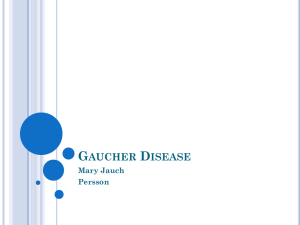
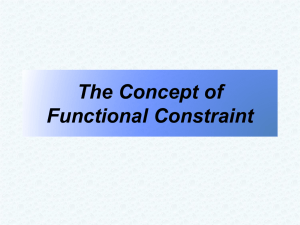
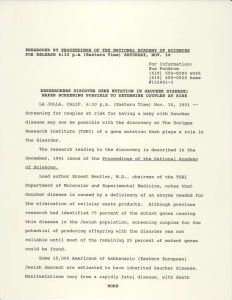
![news SCITIPPS CLINIC iI-M]](http://s2.studylib.net/store/data/012780306_1-190c4867a6190a1402e28969d4a7667c-300x300.png)
